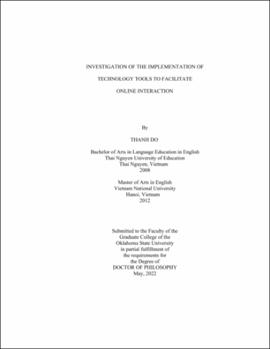| dc.description.abstract | Research has shown that online interaction and technology, which has been used to facilitate interaction, affect the success of online learning (Downing, 2012; Harper, 2018; Keengwe et al., 2013; Moore, 1989; Saadatmand et al., 2017). This dissertation aimed to address how a group of exemplary instructors effectively implement technology to incorporate interaction and interactivity in online courses. Exemplary online instructors in this qualitative study served as models to assist instructors who are novices in online teaching. In this dissertation, the theories of interaction by Moore (1989) and Hillman et al. (1994) served as the foundation concepts for interaction and interactivity in online environments. The data collection process for this qualitative study included individual interviews, observations, and documents that helped describe the types of interaction in online learning and provide the answers to the research questions. The participants in this study were recruited from a group of instructors who were nominated for the 2020 Excellence Award in Teaching Online at a comprehensive, doctoral granting university the South-Central region university in the United States. The study also applied the Teacher Response Model (TRM) of Technology Integration (Kopcha et al., 2020) to construct interview questions and analyze data collected to explore instructors’ choice and implementation of technology in their online courses. This study contributed to the interaction theories by describing how exemplary instructors chose and used technology tools to facilitate four online interaction types, including learner-content, learner-instructor, learner-learner, and learner-interface. The findings demonstrated the practices of a group of exemplary online instructors who successfully implemented technology to enhance interaction and interactivity in their online courses. The data and discussion from this study could help those who support online instructors (e.g., instructional designers/specialists and technology staff) develop strategies and methods for professional development activities. The application of the TRM (Kopcha et al., 2020) in this study provided a thorough understanding of selecting and implementing technology which could serve as a foundation for a faculty professional development session. | |
